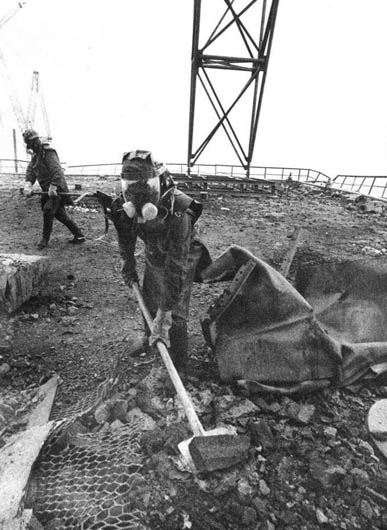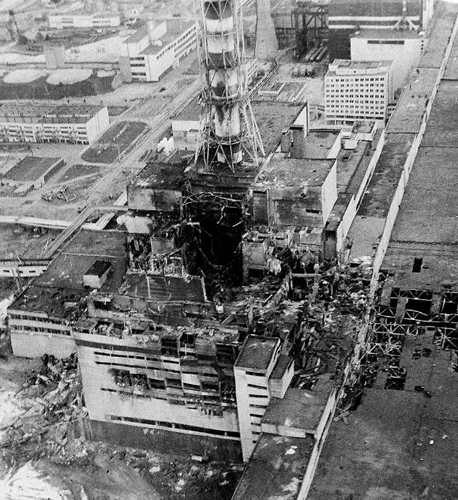Chornobyl nuclear disaster
Chornobyl nuclear disaster (Чорнобильська катастрофа; Chornobylska katastrofa). A devastating explosion that occurred on 26 April 1986 at the nuclear power station located in Chornobyl in Kyiv oblast in northwestern Ukrainian SSR, the worst disaster of its kind in the world. Its immediate cause was a test of the shutdown of reactor number four that went out of the operators’ control. A steam explosion blew the concrete roof off the reactor which together with a fire released a radioactive cloud into the atmosphere spreading over parts of Ukraine, the Belorussian SSR, RSFSR, and northern Europe. It resulted in the evacuation of the population from the area, establishment of a 30-kilometer exclusion zone, countless premature deaths and illnesses from over-exposure to radiation in the vicinity, and the reactor’s eventual entombment as well as deactivation of the entire station.
The RBMK (High Power Channel Reactor) reactors installed at Chornobyl were water-cooled and employed graphite rods to moderate the atomic reaction. Basically, water heated in the core of the reactor turns to steam which drives a turbine creating electricity and is then returned to the core. Unlike the Soviet VVER (Water-Water Energy Reactor) model, the RBMKs produced more power, used cheaper unenriched Uranium-235 fuel, and cost less to build. They were, according to their original designer, also less safe by reason of instability when starting and shutting down.
On 25 April 1986, as part of a routine shutdown for maintenance the operators began to reduce power in reactor no. 4 to prepare for a safety test. The test was meant to close a gap between shutdown of turbines and startup of emergency generators in case of an emergency. After a delay, the test and shutdown was resumed when it was already past midnight. The power dropped below the safe level at which the reactor was unstable. An unexpected power surge occurred which the operators could not control. At 01:24, two explosions occurred in succession which destroyed the reactor blowing off its concrete roof and sending highly radioactive dust into the air. The fire then spread to the roof of the adjoining reactor. It took firefighters, unaware of the radiation danger, until 06:35 to extinguish the fires except for the one in the reactor core itself. Reactors 3, 2, and 1 were shut down. At 10:00, helicopters began dumping clay, sand, boron, and dolomite into the burning reactor core to retard the radioactive emissions. The 115,000 residents of Prypiat, the bedroom community for Chornobyl workers, were kept uninformed of the disaster until their evacuation to nearby villages began in the afternoon of 27 April.
In the town of Prypiat before its evacuation, where children had been playing outdoors, radiation levels rose to several thousand times above normal. The town’s hospital was unequipped to deal with radioactive poisoning as patients—firefighters, militia, and power station operators—with acute radiation sickness arrived for treatment. Those most exposed were flown to Moscow directly. Of the 134 men and women initially diagnosed, 28 died of acute radiation poisoning within four months.
A 30-kilometer radius exclusion zone around the Chornobyl Nuclear Power Station was established. All settlements within it were to be evacuated. Work proceeded to contain and clean up the affected area. Between 600,000 and 800,000 workers were involved in bulldozing contaminated villages, destroying animals and livestock, burying immense quantities of topsoil because of contamination of crops and food, and cutting down part of a forest nearby the station. This was in addition to neutralizing the reactor. Despite the materials deposited into the actively burning reactor and the pumping of liquid nitrogen underneath to cool it, radiation levels actually increased in and beyond the zone.
On 28 April, a spike in atmospheric radiation was detected by Swedish scientists who traced its origin to the USSR. Soviet officials responded in a terse TASS statement acknowledging a nuclear accident had occurred, but claiming the situation as under control. The USSR President, Mikhail Gorbachev, only broke his silence on 14 May, in a television address in which he reassured viewers that all possible was being done to cope with the disaster and complained about Western criticism. This developed into a Soviet-American battle over the narrative relating to the disaster. The Soviet government feared a revival of Western hostility would injure Gorbachev’s ‘new thinking’ initiative in international relations, and Soviet silence on the matter of nuclear safety threatened to undermine mutual trust.
In Kyiv, the annual May Day parade went on as usual, even though radiation levels were rising and parents alarmed by rumors were already escaping with their children without waiting for official instructions. The danger was their children’s susceptibility to thyroid cancer from drinking contaminated milk. To stem the chaos, the authorities decided to end the school year early and send the youngsters to summer camps in the south. This involved evacuating nearly a million children from the city and its environs.
Radiation levels emanating from reactor no. 4 continued to fluctuate because the remedies being applied were based on guesswork about the true causes of the explosion and the condition of the reactor itself. No one in Chornobyl or Moscow knew how to deal with it. By November, a sarcophagus encasing the troubled reactor in 400,000 tons of concrete was installed. The Chornobyl Nuclear Power Plant was permanently shut down in 2000, and a new enclosure, the New Safe Confinement building was installed over the existing one in 2016. In 2011, Chornobyl became a tourist attraction.
The radioactive materials emanating for the Chornobyl reactor had varying half-lives and posed correspondingly varying dangers. Half-life refers to the length of time in which the mass of a radioactive isotope has through the process of radiation been reduced in half. Iodine-131, with a half-life of eight days, has ceased to be harmful to the human body for people in the area of the disaster or downwind at the time. Plutonium-239, detected as far away as Sweden, has a half-life of 24,000 years. Some radionuclides will remain forever in the region.
Over 350,000 people had to be evacuated from the areas most contaminated, more than 780,000 hectares of agricultural land were taken out of production, and timber harvesting was curtailed on 700,000 hectares of forest. At least 6,000 cases of thyroid cancer in children had been detected by 2005 among those exposed to radiation. Among adults, there were cases of leukemia, cataracts, and other cancers attributable to radiation exposure. Chornobyl nuclear disaster’s victims numbering in the millions were given pensions, special health benefits, and free holidays, an extra burden on the state budget.
The accident itself together with the Soviet government’s response to it had grave consequences for the USSR. It exposed the fatal flaw in the RBMK reactor design, the carelessness of Soviet officials in handling the disaster, the disregard for public well-being, and the incapacity of the Soviet system for honesty, truth, and openness. It dealt a blow to the nuclear power industry worldwide over the unresolved problem of nuclear safety. Attempting to prevent panic, authorities responded with silence and reassurances that all was under control, but doing so only further discredited themselves and undermined their legitimacy in a fatal way. In 2006, Mikhail Gorbachev wrote of the Chornobyl nuclear disaster that it, not perestroika, caused the collapse of the Soviet Union.
The Chornobyl catastrophe was a historical landmark for Ukraine launching its exit from the USSR. The event was seen immediately as a national disaster by leading dissidents, writers, and intellectuals, as well as by ecological-environmental activists, and made a priority issue. Meetings were held with Volodymyr Shcherbytsky and Mikhail Gorbachev urging a halt to the building of nuclear power plants. Rallies were organized to protest against the proliferation of further ‘dead zones.’ Ukrainian leaders were persuaded to stand up against Moscow’s decisions on nuclear power and by implication on the future of Ukraine. These same actors created the informal organization the Popular Movement of Ukraine (Rukh) to promote political reform and openness (see neformaly). The general dissatisfaction unleashed by the Chornobyl nuclear disaster eventually led to the 1991 Ukraine’s Declaration of Independence.
BIBLIOGRAPHY
Marples, David R. Chernobyl and Nuclear Power in the USSR (Edmonton 1986)
———. The Social Impact of the Chernobyl Disaster, with introduction by Victor G. Snell (Edmonton 1988)
Shcherbak, Iurii. Chernobyl: A Documentary Story (Edmonton 1989)
Daniloff, N. ‘Chernobyl and Its Political Fallout: A Reassessment,’ Demokratizatsiya, 12, no. 1 (Winter 2004)
Greenpeace. The Chernobyl Catastrophe: Consequences on Human Health (Amsterdam 2006)
Plokhy, Serhii. Chernobyl: The History of a Nuclear Catastrophe (New York 2018)
Biitsi nevydymoi viiny (Cherkasy 2019)
Bohdan Harasymiw
[This article was written in 2023.]

.jpg)

